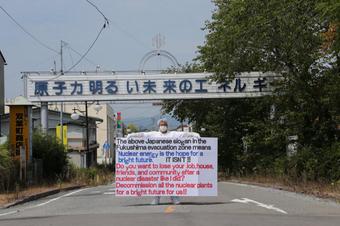CNIC Statement: 11 years since the TEPCO Fukushima Daiichi Nuclear Power Station accident
March 11, 2022
Eleven years have passed since the Great East Japan Earthquake occurred. The difference between the time (lifespan) of radioactive materials and the time of human society has plagued us for 11 years.
If it had only been a massive earthquake and tsunami that struck, both natural ecosystems and human society would be able to recover to a reasonable degree. However, the radiation disaster can only end with the decay of the radioactive materials and this has left us with a painful realization of how helpless we are.
Cesium-137, the most abundant radioactive material released into the environment from TEPCO’s Fukushima Daiichi Nuclear Power Station, will finally be reduced by half after 30 years of waiting. The half-life is said to be 30 years. This means that we will have to wait twice as long as we have been waiting to halve the amount of cesium-137. If we wait 10 times longer than the half-life, or 300 years, the amount of cesium-137 will be reduced to one-thousandth of its original amount.
Because the amount of radiation coming out of that radioactive material takes such a long time to decrease, the future of the clean-up of the accident is not clear. The removal of the melted down fuel debris, the disposal of contaminated water, and the return of people to their hometowns are all tied up in radioactive time.
 These are the solemn facts brought about by our dream that technology for developing nuclear bombs could somehow be made “peaceful.” Nuclear power, it turned out, was not “the energy of a bright future.” The earthquake, followed by the tsunami, caused a total loss of power, and the nuclear power plants were out of control. Hydrogen explosions occurred one after another. Eleven years later, the details of this process are still unknown. Recently, there have been claims that nuclear power is an established technology, that it is necessary to achieve decarbonization, and that nuclear power should be promoted. However, a technology that cannot be controlled in an emergency cannot be considered an established technology. Furthermore, the method of disposing of radioactive waste has not yet been determined. Again, the problem of time cannot be solved. Radioactive materials with a life span of tens of thousands of years are contained in the waste.
These are the solemn facts brought about by our dream that technology for developing nuclear bombs could somehow be made “peaceful.” Nuclear power, it turned out, was not “the energy of a bright future.” The earthquake, followed by the tsunami, caused a total loss of power, and the nuclear power plants were out of control. Hydrogen explosions occurred one after another. Eleven years later, the details of this process are still unknown. Recently, there have been claims that nuclear power is an established technology, that it is necessary to achieve decarbonization, and that nuclear power should be promoted. However, a technology that cannot be controlled in an emergency cannot be considered an established technology. Furthermore, the method of disposing of radioactive waste has not yet been determined. Again, the problem of time cannot be solved. Radioactive materials with a life span of tens of thousands of years are contained in the waste.
In the midst of the war in Ukraine, the Zaporizhzhia and Chornobyl nuclear power plants are in danger. The Chornobyl and Fukushima nuclear accidents occurred during peace time but now the possibility has been raised of an even worse radiation disaster occurring.
For the sake of a sustainable society and future generations, the current generation that attempted to use nuclear power, has the responsibility to end it.
